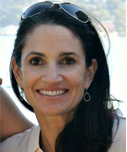TWENTY YEARS AGO, Zoë Elton, the director of programming for the Mill Valley Film Festival, conducted what she describes as “rudimentary research” to discover the number of female directors in the film industry. At the time she came up with somewhere between 5 and 7 percent. So in 2013, when Stacy Smith, a professor and founder of the Inclusion Initiative at the Annenberg School at USC, joined a panel at the Mill Valley Film Festival and revealed that today the number of female directors in Hollywood still hovers somewhere between 5 and 7 percent, Elton had an aha moment.
“The lightbulbs just flashed,” she says. “It was stunning to realize that the percentage of women who were being hired as directors in Hollywood hadn’t changed over two decades. Then, of course, you realize they haven’t changed over three decades or four decades. So out of that was born the question: what can we do?”
Faced with Stacy Smith’s definitive data about the lack of progress for women in film (made memorable by Frances McDormand’s “inclusion rider” speech at 2018’s Academy Awards), Elton understood that it was time to make gender representation a priority. “We felt it was time to really bring women’s work and parity forward for the Mill Valley Film Festival,” she says. “Not to just say, oh yeah, we do this, but to be bold about it and to articulate it in ways that are palpable and tangible and offer inspiration for others.”
In 2015, the California Film Institute (CFI) formally launched Mind the Gap at the Mill Valley Film Festival with the intention of addressing the range of issues that affect women in the world of film. In 2017, the festival hosted the first Mind the Gap Summit, a full-day intensive of presentations, classes, networking and conversation around hiring and inclusion. The day before that inaugural event, the Harvey Weinstein story broke and, day by day, painful revelations of other sexual abuse accusations surfaced as the summit and festival took place. “That really set the tone for that first summit,” Elton says. “People’s need for this kind of work, for the connections, for the community and inspiration amongst people who are doing work to forward the causes of gender equity, inclusion and parity — that was really profound.” Then, the next year, the contentious Brett Kavanaugh Supreme Court nomination hearings unfolded in parallel timing with the Mind the Gap Summit, further connecting the work of the festival to social realities and to the #MeToo movement. “There’s been this cycle in our lives that has made Mind the Gap so timely and so necessary,” Elton says.
In 2018, while attending the Cannes Film Festival, the MVFF team signed a gender equity pledge entitled 50/50 by 2020, publicly committing to the goal of equal representation in programming by the year 2020. The 50/50 by 2020 initiative rose from Hollywood alongside the #MeToo and #TimesUp movements and has gained traction across the globe. Hollywood agencies, including International Creative Management and United Talent Agency, media companies such as VICE media, and major film festivals like Cannes, Venice and Berlin have all signed the pledge. The Mill Valley Film Festival was one of the first U.S. festivals to sign. “
We’d already been doing that work so it was really a case of being in solidarity as a worldwide movement,” Elton says. Currently only five other U.S. festivals have committed to the pledge, a fact Elton attributes to the difficulty of achieving parity in a festival lineup that includes Hollywood films. “As soon as we start adding Hollywood films into the mix, our (programming equity) percentages go down. That is why a lot of other film festivals don’t sign on.” In other words, the independent film community has made significantly more progress toward gender equity than Hollywood has.
The landscape in Hollywood, despite recent attention to inequality, has not evolved, and the numbers speak for themselves. In 91 years of Academy Awards, only five women have been nominated for Best Director, and, according to recent USC Annenberg Inclusion Initiative research, today 96 percent of “top 100” (read big-name, big-budget) Hollywood studio directors are men. What makes it so difficult for women, who comprise approximately half the total number of film school graduates, to gain a directorial stronghold? “When money comes in, when the budgets are higher, research shows, the women fall out,” says Alison Emilio, a Mind the Gap Summit panelist and director of ReFrame, a Los Angeles–based organization that has developed a stamp of approval for productions meeting key benchmarks in gender parity and diversity hiring.
“There is a bias when it comes to money. So, how do we hack that bias and change those numbers?” Emilio asks. One answer is her organization’s ReFrame Rise Directors Program, which pairs talented mid-career female directors with established industry “ambassadors” who serve as sponsors to help them advance further in the film and TV worlds. “This will create a change in diversity and content and, at the same time, studies show that women hire women,” she adds, “so we are creating a systemic change down the line.”
Emilio sees programs like the Mind the Gap Summit as critical for promoting the conversation about equality in film. “This is a great place for those of us doing this work to collaborate,” she notes. “It’s a meeting place for us to find out what (inclusion advocacy) organizations like Women and Hollywood are doing, or what Zoë and her festival team are doing. We improve our ideas by sharing and hearing about what else is happening out there in the field, and then we build on the work.”
The theme of the 2019 Mind the Gap Summit is straightforward: money. “Financing is very important. Power is very important. Money and power go hand in hand,” Elton says. “The reins of power in Hollywood have been held by men exclusively for a long time.”
Summit panels this year will address the nuts and bolts of financing, pay equity and the power dynamics in the industry that underlie stagnant numbers. The Mind the Gap Award, an annual prize honoring an industry leader’s work to close the gender gap, will be presented to Swedish Film Institute CEO Anna Serner. Under Serner the Swedish Film Institute has distributed funds equally to male and female filmmakers and published a 2018 report entitled “The Money Issue,” analyzing financial and investment data in the film industry and its relevance to working conditions for female filmmakers, as compared with their male counterparts. The summit’s overall goal: to give female filmmakers practical guidance for successfully securing funds for projects. “In A Room of One’s Own” Virginia Woolf wrote, ‘A woman must have money and a room of her own if she is to write fiction,’ ” says Elton. “Almost 100 years later, that’s the quote that has been driving me.”
At the time of printing, Elton could not say for sure that the festival has reached 50/50 in 2019, but it’s very close — enough to be confident of parity for 2020 (it was 45 percent in 2018). Beyond the important work of tracking how many female directors, producers, writers, cinematographers and editors are on production teams, the Mind the Gap program and its 2020 parity pledge have expanded and enriched the content of the festival, Elton adds. “With these initiatives, we programmers have gotten into much more incisive conversations,” she says. “We look at whether female characters have agency, or if they are just being reactive or sidelined. These aren’t just conversations about women, but about story in general, and how stories are told.”
This article originally appeared in the October 2019 issue of Marin Magazine.
 Kirsten Jones Neff is a journalist who writes about all things North Bay, with special attention to the environment and the region’s farmers, winemakers and food artisans. She also works and teaches in school gardens. Kirsten’s poetry collection, When The House Is Quiet, was nominated for the Northern California Book Award, and three of her poems received a Pushcart nomination. She lives in Novato with her husband and three children and tries to spend as much time as possible on our local mountains, beaches and waterways. For more on her work visit KirstenJonesNeff.Com.
Kirsten Jones Neff is a journalist who writes about all things North Bay, with special attention to the environment and the region’s farmers, winemakers and food artisans. She also works and teaches in school gardens. Kirsten’s poetry collection, When The House Is Quiet, was nominated for the Northern California Book Award, and three of her poems received a Pushcart nomination. She lives in Novato with her husband and three children and tries to spend as much time as possible on our local mountains, beaches and waterways. For more on her work visit KirstenJonesNeff.Com.

